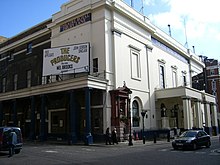This is an old revision of this page, as edited by Bunchofgrapes (talk | contribs) at 04:34, 28 March 2006 (→1663-1672: apos). The present address (URL) is a permanent link to this revision, which may differ significantly from the current revision.
Revision as of 04:34, 28 March 2006 by Bunchofgrapes (talk | contribs) (→1663-1672: apos)(diff) ← Previous revision | Latest revision (diff) | Newer revision → (diff)

from Russell Street and Catherine Street
The Theatre Royal, Drury Lane is a theatre in the West End area of London, officially situated on Catherine Street, but backing onto Drury Lane just to the east of Covent Garden.
A cockpit in that location was converted into a theatre during the reign of James I. After the Restoration of the monarchy in 1660, a splendid new theatre was built to designs by Christopher Wren. Having been razed by fire on January 25 1672, it was succeeded by a larger and still more elaborate building also designed by Wren, which housed two thousand spectators with the opening attended by Charles II on March 26 1674.
The great English actor David Garrick managed the theatre during the mid-eighteenth century, during which time he produced many plays, including most of Shakespeare's work.
By the end of the 18th century, the building was in need of updating, and was demolished in 1791. A third theatre was designed by Henry Holland and opened on March 12 1794, lasting for only 15 years before burning down on February 24 1809.
The present Theatre Royal in Drury Lane, designed by Benjamin Wyatt, opened on October 10 1812 with a production of Hamlet. The interior has been substantially redesigned and overhauled many times since then: a contemporary sketch of it when it was new is shown on the right, seen from the point of view of the beau monde in the lower gallery. It is one of the West End's largest, and has been the setting for appearances by Edmund Kean and Sarah Siddons, among others.
With a capacity of 2,205, it has been home to many large productions over the years. It is currently showing a revival of Mel Brooks' musical The Producers.
1663-1672
Charles II returned to the English Throne in 1660 after the decade-long Puritan Interregnum, which had seen the banning of pastimes seen as frivolus, including theatre. It was not long after this Restoration that Charles issued patents to two parties licensing the formation of new acting companies. One of these went to Thomas Killigrew, whose company would become known as the King's Company, and who would build a new theatre in Drury Lane. This playhouse, designed by Christopher Wren, opened on May 7 1663. It was a three-tiered wooden structure, 112 feet long and 59 feet wide; it could hold 700 audience members. The King himself was a not infrequent attendee of the theatre's productions, as was Samuel Pepys, whose detailed diaries provide much of what we know of the Restoration period in general and the theatre in particular. The day after the Theatre Royal opened, Pepys would attend a performace of The Humerous Lieutenant. He has this to say in his diary:
The house is made with extraordinary good contrivance, and yet hath some faults, as the narrowness of the passages in and out of the Pitt, and the distance from the stage to the boxes, which I am confident cannot hear; but for all other things it is well, only, above all, the musique being below, and most of it sounding under the very stage, there is no hearing of the bases at all, nor very well of the trebles, which sure must be mended.
Performances usually began at 3 pm to take advantage of the daylight: the main floor for the audience, the pit, was unroofed so as to let in the light. A glazed dome was built over the opening, but to judge from another one of Pepys' diary entries, the dome was not entirely effective at keeping out the elements: he and his wife were forced to leave the theatre to take refuge from a hail storm.
In the summer of 1665, the Great Plague of London struck, and on 5 June the Theatre Royal, along with all other public entertainment, was shut down by order of the Lord Mayor and Aldermen of the City of London. It remained closed for 18 months, until the autumn of 1666. Though the theatre survived the Great Fire of London, which raged through the city in September of that year (and may have hastened the end of the plague), it was to burn down six years later, on January 25 1672.
Principal recent productions
- Pirates of Penzance (May 26, 1982 - October 29, 1983)
- 42nd Street (August 8, 1984 - January 7, 1989)
- Miss Saigon (September 20, 1989 - October 30, 1999)
- The Witches of Eastwick (July 18, 2000 - February 24, 2001)
- My Fair Lady (July 21, 2001 - August 30, 2003)
- Anything Goes (October 7, 2003 - August 28, 2004)
- The Producers (November 9, 2004 - )
Nearby Tube Stations
Notes
- Beauclerk, Charles (2005). Nell Gwyn: Mistress to a King. Atlantic Monthly Press. ISBN 0-87113-926-X. pp 59–60.
- Pepys diary for May 1663. From www.pepys.info.
- Beauclerk p. 60